The kitchen is the heart of every home. Crafting a kitchen that not only serves your culinary needs but also exudes your personal style can be a rewarding endeavor. One of the core challenges in this quest is ensuring that the cabinets and countertops harmonize perfectly. This isn’t just about aesthetics; a cohesive kitchen design can uplift your mood and even impact how you interact with the space.
When it comes to creating the perfect kitchen ambiance, matching your cabinets and countertops is an essential step that can’t be overlooked. The interplay of colors, textures, and materials sets the tone for your kitchen’s overall look and feel.
Many homeowners often wonder, ‘How do I match my kitchen cabinets?’ It’s a valid question and one that merits a deep dive.
In this comprehensive guide, I’ll delve into the art of harmonizing kitchen cabinets and countertops, ensuring your culinary space becomes a masterpiece that reflects your style and taste.
The role of kitchen cabinets
Kitchen cabinets are more than just storage spaces; they’re the visual anchors of your kitchen’s design. These cabinets play a pivotal role in influencing your countertop choices, and as such, they deserve your careful consideration. Since cabinets tend to be a significant investment in kitchen design, it’s crucial to take your time and choose a style that resonates with your aesthetic preferences and budget.
The significance of countertop selection
Selecting the right countertop material and color is equally vital as it complements your cabinets and contributes to the overall visual appeal of your kitchen. Countertops are not only workspaces but also design elements that tie your kitchen’s elements together. A well-chosen countertop can elevate the entire look and feel of your kitchen.
Should countertops match cabinets?
Whether countertops should match cabinets is a matter of personal preference and design philosophy. While some homeowners opt for a harmonious color scheme, others choose to play with contrasts to create visual interest.
Both approaches have their merits, and the choice ultimately depends on the style you’re aiming for and the atmosphere you wish to create in your kitchen.
What’s the first element you select when planning a kitchen design?
The initial element often chosen when designing a kitchen is the layout, ensuring functionality. After that, many designers recommend starting with the countertop or cabinetry, as they dominate the space and set the tone for other design choices.
Key factors to consider when matching
1. Leveraging the color wheel
Understanding the color wheel can be your secret weapon in crafting a harmonious kitchen design. Complementary colors, those opposite each other on the wheel, can create dynamic pairings.
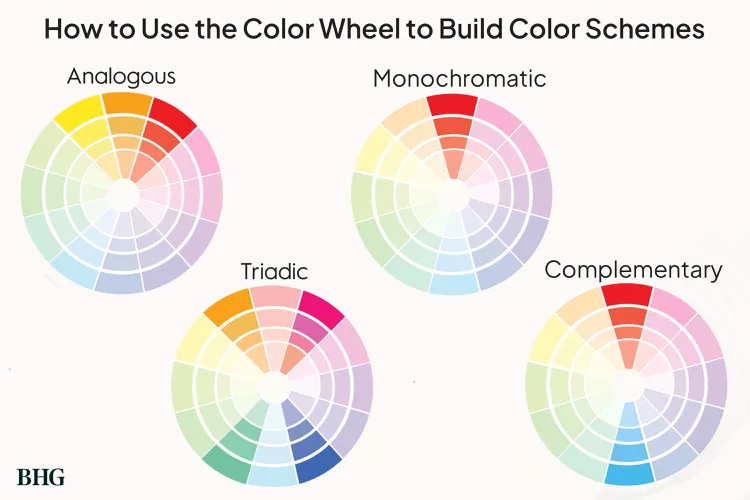
For instance, if your cabinets are in a warm color like brown, consider contrasting them with a cooler-toned countertop, like gray or blue. This interplay adds depth and visual intrigue to your kitchen.
Familiarize yourself with:
- Complementary colors: Opposite each other on the wheel, they create dynamic contrasts. Think blue cabinets with orange-toned wood countertops.
- Analogous colors: Adjacent on the wheel, they offer a serene, harmonious look. Imagine light green cabinets paired with soft blue or turquoise countertops.
- Neutral tones: These include whites, blacks, and grays. They provide flexibility and are timeless.
2. Texture and material harmony
Beyond color, texture and material also play a vital role in matching cabinets and countertops. Combining textures like sleek cabinets with a glossy countertop or rustic cabinets with a matte, textured surface can create a balanced yet visually captivating composition.
Natural materials like wood, granite, or marble offer organic, timeless beauty. A rich, mahogany cabinet paired with swirling beige granite exudes luxury.
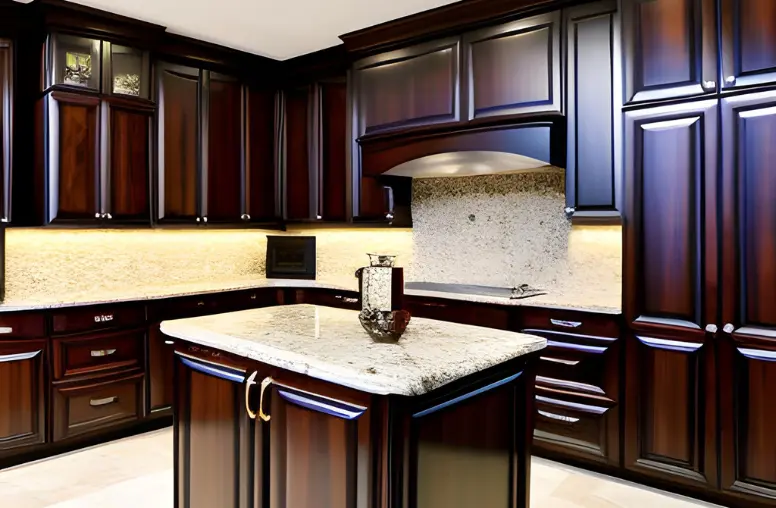
Man-made materials, on the other hand, such as quartz or laminate, provide modern appeal and varied customization options.
3. Current trends
Never underestimate current trends. They might provide that modern edge you desire. However, it’s also essential to balance them with timeless choices to ensure longevity in your design.
4. Light
Lastly, consider the play of light. How does morning sunlight bounce off your cherry wood cabinet? How does the under-cabinet LED light reflect on your marble countertop? Lighting can either accentuate or diminish the beauty of your chosen materials, so always be observant.
Strategies for successful pairing
Now let’s look at how to match kitchen cabinets and countertop.
When kickstarting your design journey, ponder upon this: Should your countertop lead or your cabinet? Personally, I’ve found that starting with a countertop offers a better canvas to paint on, but there’s no hard rule. Sometimes, a unique cabinet wood or color can inspire the countertop choice.
Backsplashes are like the unsung heroes of kitchen design. They act as a bridge, tying your cabinets and countertops together seamlessly. A mosaic backsplash with colors from both your cabinet and countertop can be the harmonizing factor.
Before taking the plunge, always experiment with samples. Visualizing a small slab of quartz with a cabinet sample can provide insights that imagination simply cannot. And oh, don’t overlook your cabinet hardware and fixtures. They’re like the jewelry of your kitchen, often providing that final touch of cohesiveness.
Popular cabinet and countertop combinations
1. Classic combinations
For those who love timeless grace, classic combinations never fail. The pristine aura of white cabinets set against a dark granite countertop is always in vogue. Or, if you lean towards earthy vibes, natural wood cabinets juxtaposed with light-colored quartz can be your go-to.
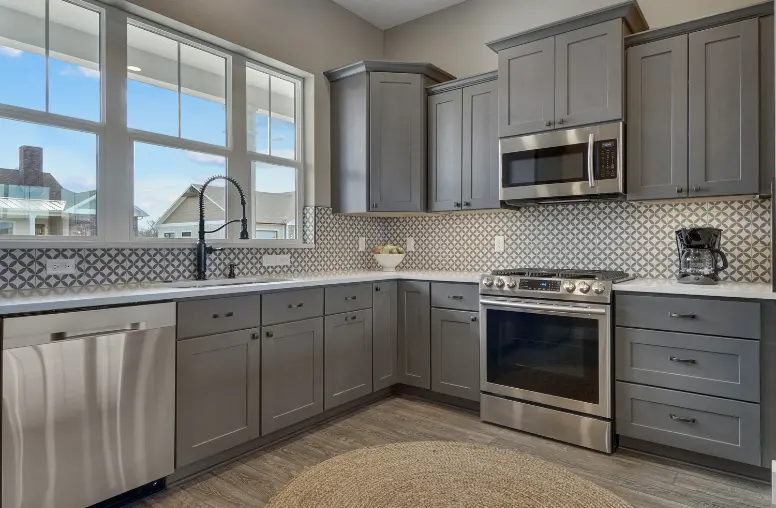
2. Contemporary pairings
Now, for my modern mavens, contemporary pairings are a treasure trove of inspiration. Two-toned cabinets, perhaps a mix of matte black and deep blue, contrasted with minimalist, sleek countertops, can set a bold tone.
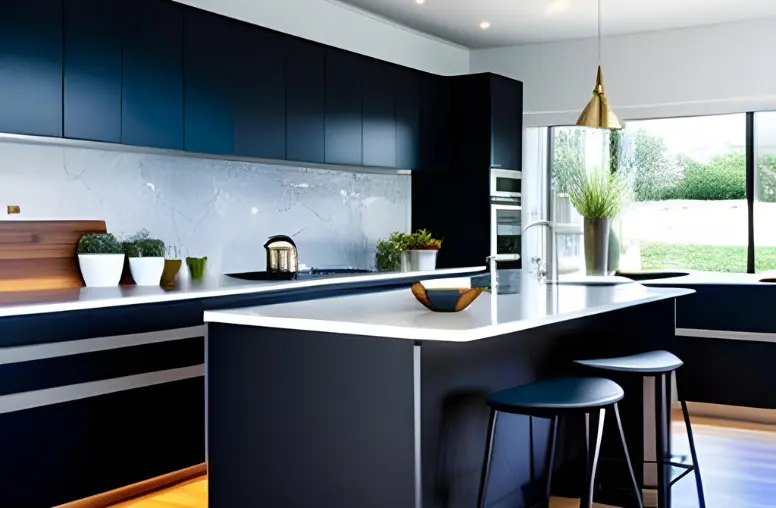
On the other hand, the industrial allure of concrete countertops paired with matte black cabinets is simply hard to resist.
3. Eclectic mixes
For the brave souls who love to tread off the beaten path, eclectic mixes can be deeply satisfying. Imagine cabinets reclaimed from old barns, paired with a vibrant, patterned countertop. Or, a daringly painted cabinet in royal purple paired with a subdued, neutral countertop. The results can be truly captivating.
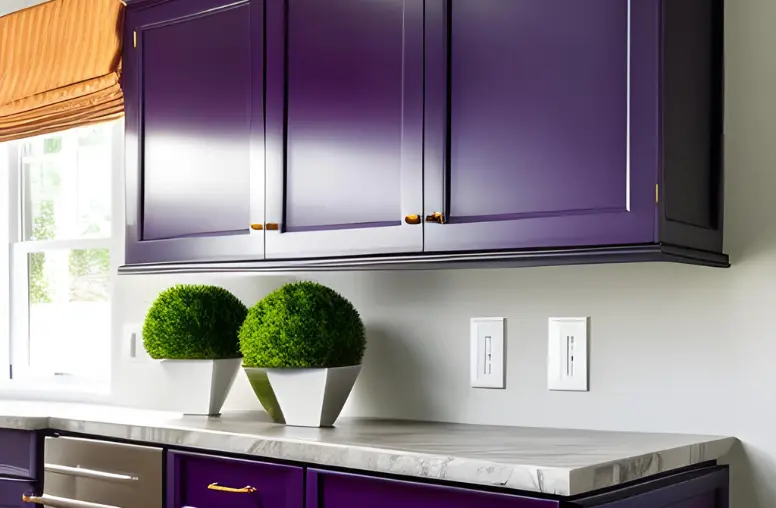
What color countertops go with dark cabinets?
Pairing dark cabinets with countertops is a design opportunity to create striking contrasts or elegant harmonies. If you’re aiming for contrast, opt for light-colored countertops like white, beige, or light gray. These choices will not only balance the darkness of the cabinets but also create a visually dynamic and eye-catching effect.
On the other hand, if you prefer a more sophisticated and cohesive look, consider dark countertops with rich tones like black, deep brown, or charcoal gray. This approach creates a seamless and luxurious aesthetic, allowing the dark cabinets to stand out while maintaining a unified ambiance in your kitchen.
How many color shades are ideal for a kitchen setting?
When considering the ideal number of color shades for a kitchen, it’s generally recommended to stick to a palette of three to five complementary shades. This approach often creates a harmonious and balanced kitchen aesthetic.
Should your backsplash coordinate with your countertop or cabinet?
Your backsplash doesn’t strictly need to match, but it should coordinate or complement either your countertop or cabinetry, creating a seamless and cohesive look.
Common mistakes to avoid
As with any design endeavor, pitfalls are to be avoided. Ensure you:
- Balance bold choices with neutral accents to maintain visual equilibrium. While contrasts can be captivating, ensure they’re not overwhelming.
- Consider both natural and artificial lighting when making your choices to avoid unwanted surprises. Lighting can significantly impact how colors appear.
In the sea of choices, it’s easy to go overboard. Beware of selecting overwhelming patterns for both cabinets and countertops; it can create visual chaos.
Another aspect to keep in mind is maintenance. That pristine white marble might look divine, but if you’re a red wine enthusiast or an avid beet salad maker, staining could become your nemesis.
The balance between beauty and functionality is essential. So, while you’re smitten by a particular design, ask yourself: Does it align with your kitchen’s layout and functionality?
Lastly, your appliances and other fixtures also have a say in this symphony. A brushed steel refrigerator, a copper sink, or even a brass faucet can either create melodious harmony or cacophonous discord, so plan accordingly.
Seeking professional advice
While this guide provides insights and strategies, don’t hesitate to consult with design professionals. Their expertise can guide you in selecting the ideal granite and cabinet combination that aligns with your vision, lifestyle, and kitchen’s layout.
Conclusion
Building a harmonious kitchen is akin to crafting art. Your cabinets and countertops are but two instruments in an orchestra, but their harmony sets the tone. While trends come and go, your kitchen is your personal canvas, so paint it with your individuality. However, knowing the basic principles ensures that your masterpiece stands the test of time.
I’d love to hear about your kitchen triumphs. Have a combination that worked wonders? Share it with our readers. If you’re still on the fence or simply love professional input, always feel free to consult with design gurus.
